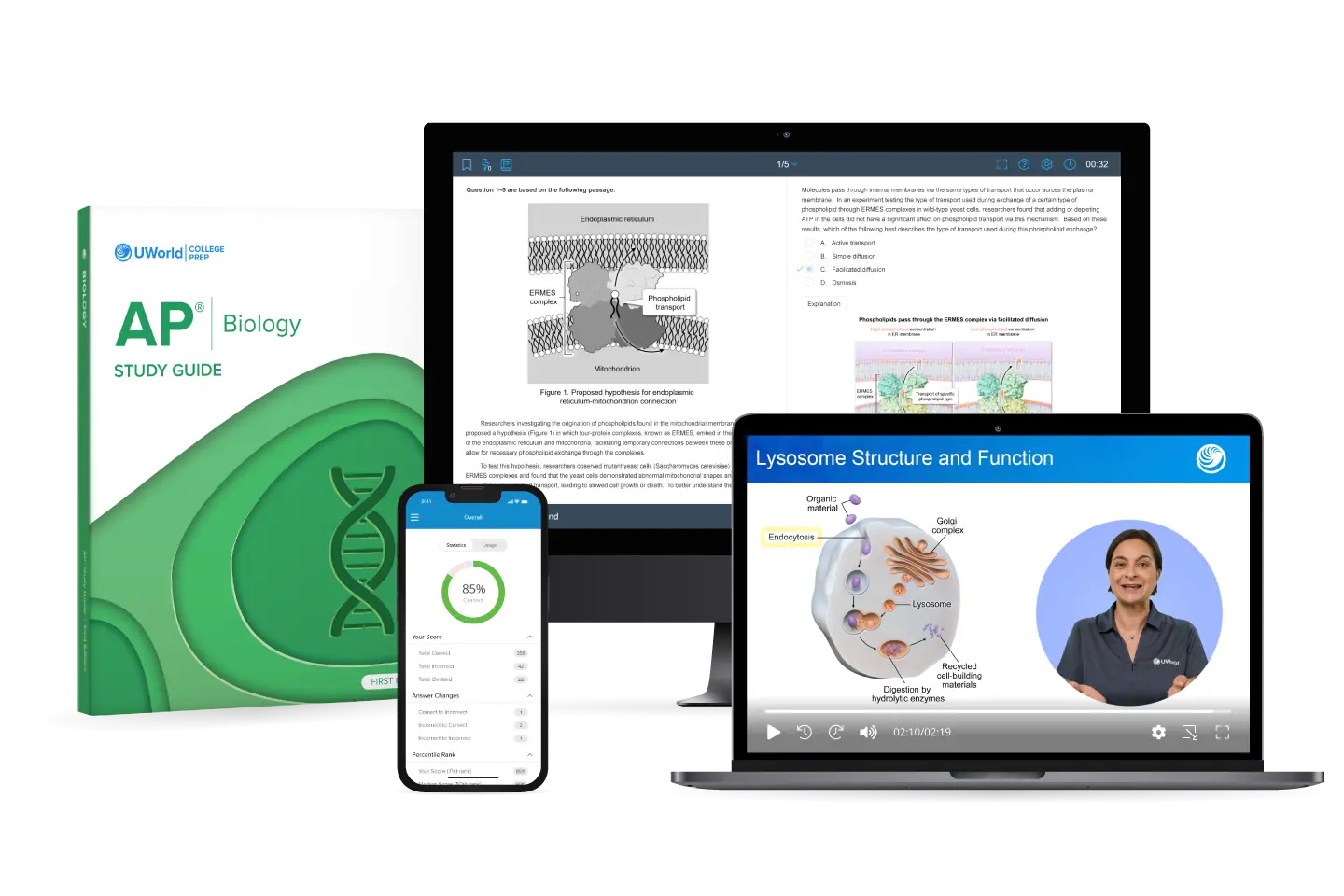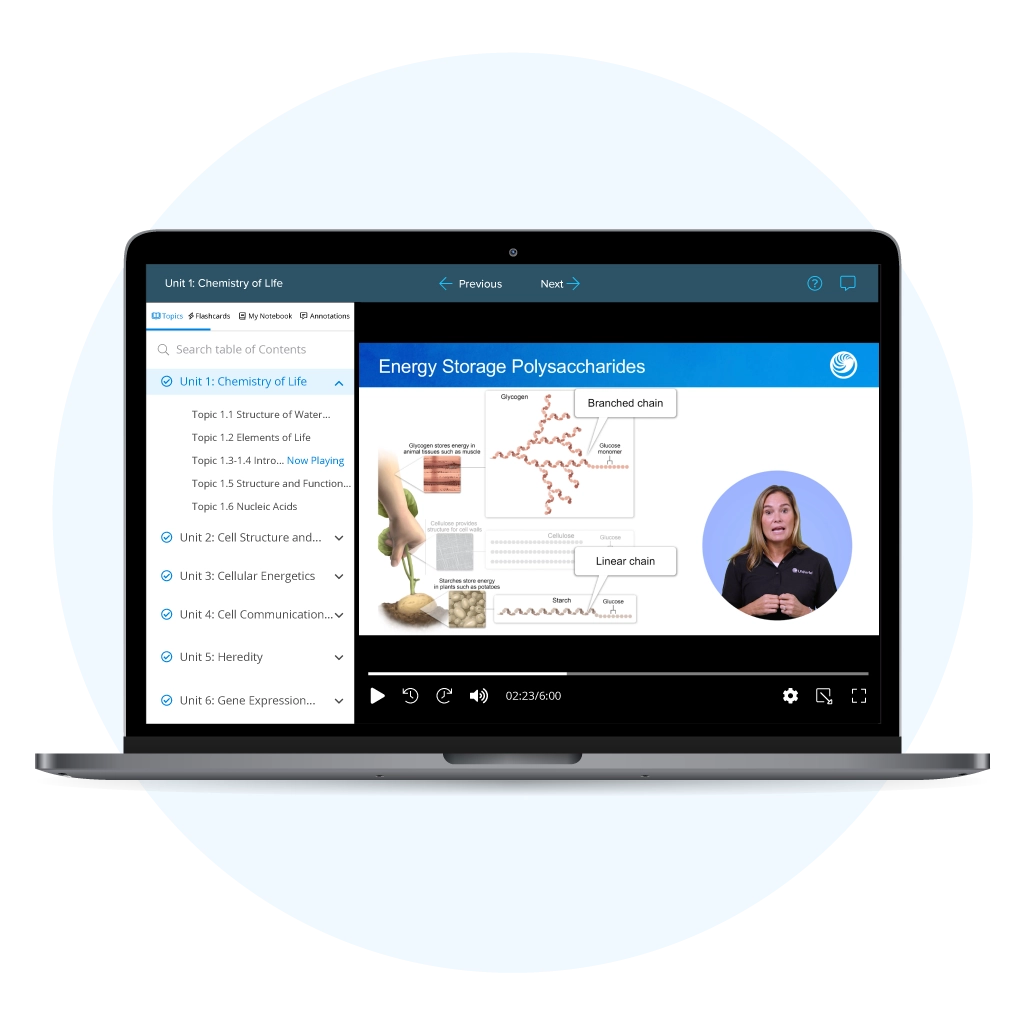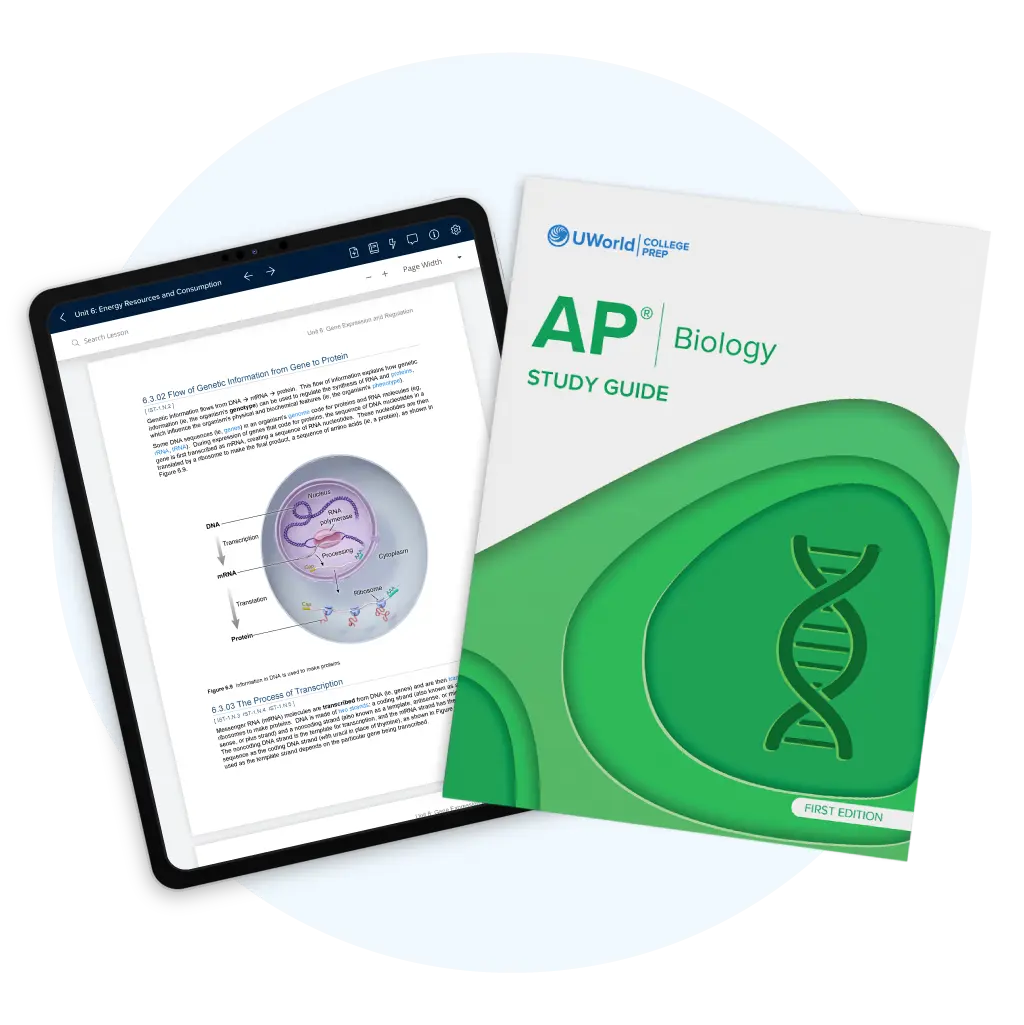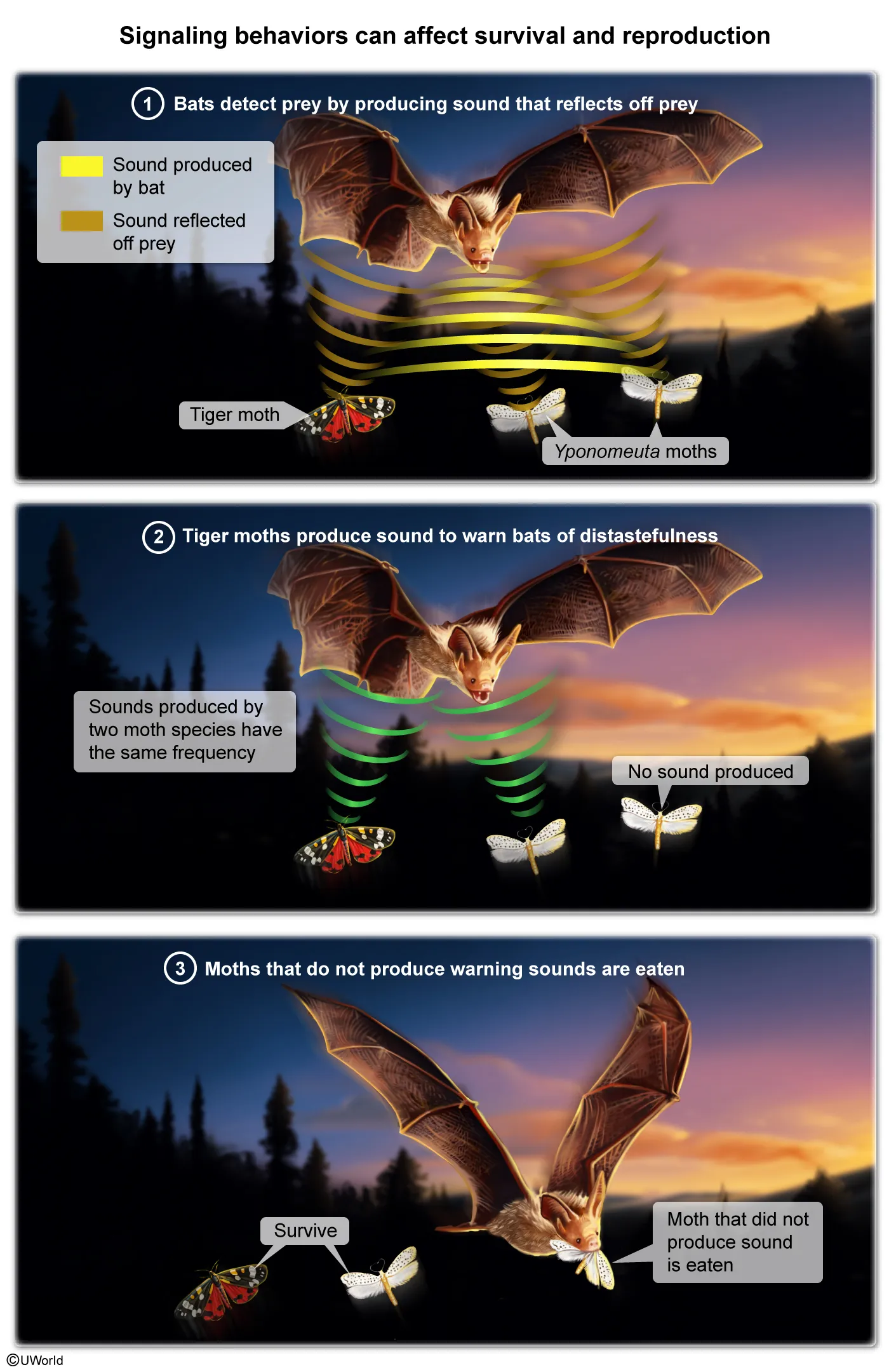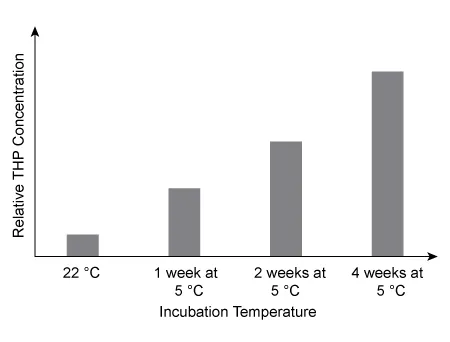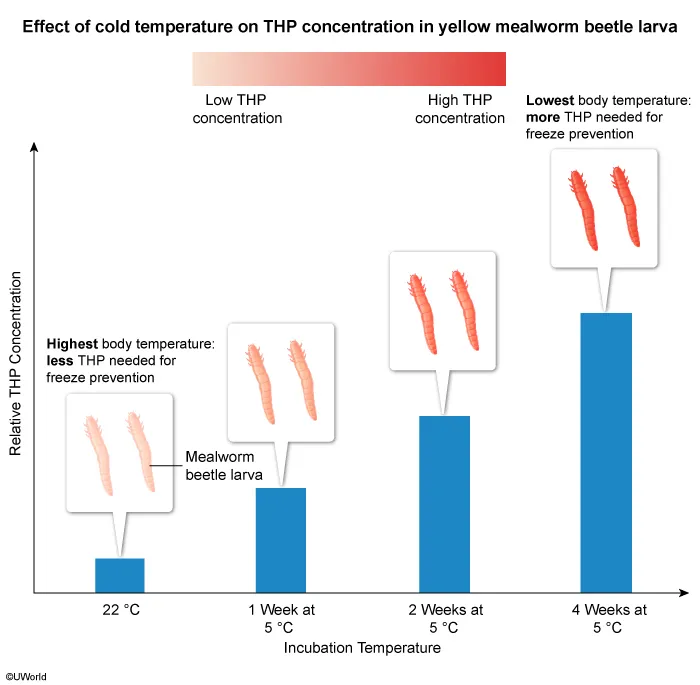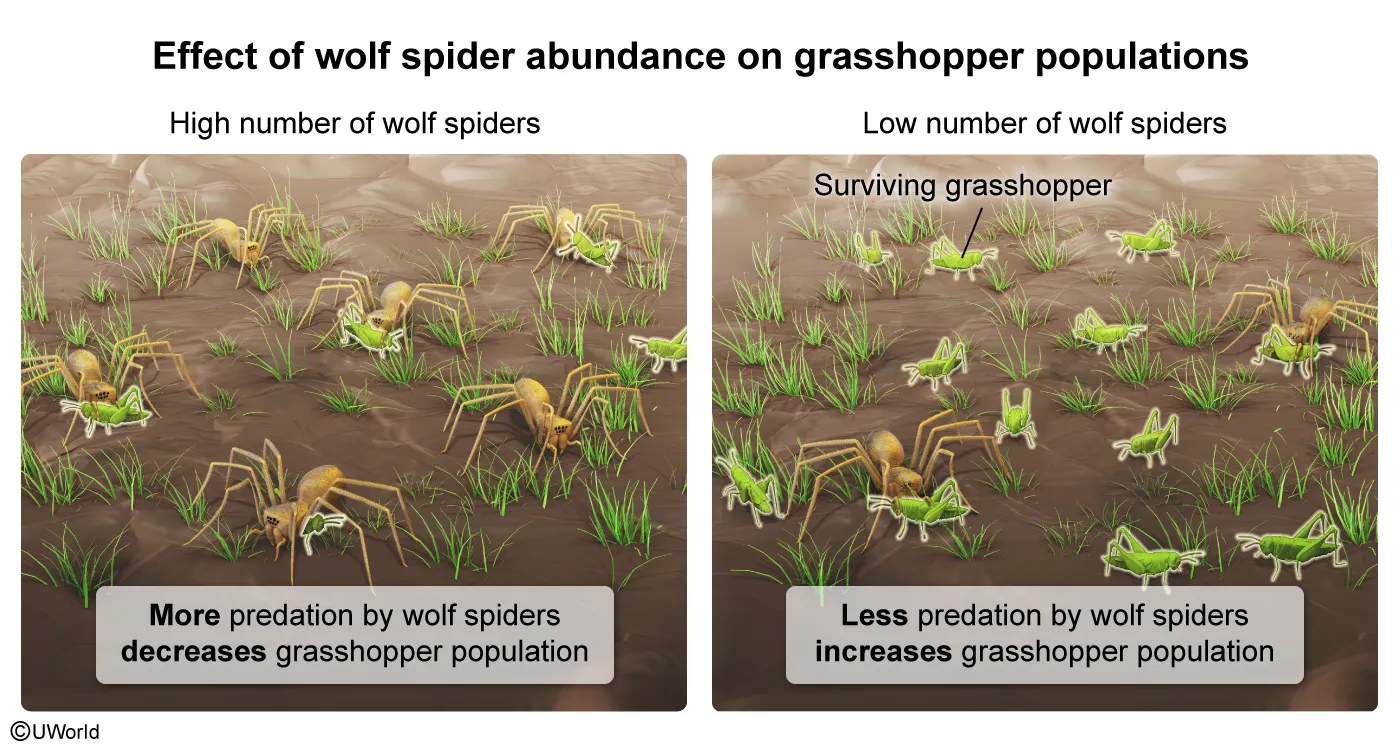AP® Biology Unit 8 Review and Practice Test
Confused about where to begin your AP® Biology Unit 8 review? Here is your one-stop solution! UWorld brings you a comprehensive coverage of Ecology, where AP specialists provide step-by-step explanations of topics like Population, Ecology, Community Ecology, Biodiversity, and more. In addition, our exam-level AP Bio Unit 8 MCQs strengthens your understanding of concepts and brings you closer to scoring a 5.
Boost Your Confidence and Score High with Our AP Biology Unit 8 Review
Ready to kickstart your Unit 8 AP® Bio prep? Our study materials make even the toughest topics easy to understand. Together, our study guide, question bank, video lessons, and study tools provide students an all-in-one learning experience, helping them study smarter, not harder.
Engaging Video Lessons
Say no to boring, text-heavy explanations! UWorld offers short, focused, and image-rich AP Biology Unit 8 video lessons to simplify complex concepts, helping you learn faster, understand better, and retain longer.
Interactive Study Guides
Our study guide is aligned with the College Board® CED, so you study the most relevant content. Each topic comes with thorough explanations, well-labelled diagrams, and check-points to fully prepare you for the exam.
Try These AP Biology Unit 8 Practice Test Questions
Question
Bats are flying mammals that can locate quiet flying prey (eg, moths) in the dark by producing sound waves at certain frequencies that reflect off the prey back to the bat. Bats' ears are specialized to detect the reflected sound frequencies.
Some species of tiger moths (genus Cisthene) carry toxins from plants they feed on. These toxins make the tiger moths distasteful to bats. Bats learn to avoid eating such toxin-carrying moths because the tiger moths produce sounds at specific frequencies that the bats can detect. Other moth species (genus Yponomeuta) produce sounds at the same frequency as those produced by tiger moths.
Which of the following claims is most consistent with this information?
| A. Yponomeuta moths that produce less sound are less likely to be eaten by bats. | |
| B. Bats cannot detect sounds at the frequency produced by Yponomeuta moths. | |
| C. Yponomeuta moths that sound like tiger moths to bats produce more surviving offspring. | |
| D. Tiger moths and Yponomeuta moths obtain the same toxins by eating the same plants. |
Explanation
Signaling behaviors can affect organisms from the same or different species and increase organisms' reproductive success (ie, evolutionary fitness) in various ways (eg, improving self-defense, increasing the ability to obtain food and find mates).
According to the question, certain toxin-carrying tiger moths are distasteful to bats and produce sounds at frequencies detected by bats. Therefore, bats learn to avoid eating these tiger moths.
However, some moths of the genus Yponomeuta produce sounds at the same frequency as the tiger moths that are distasteful to bats. Because bats tend to avoid eating the distasteful tiger moths, bats would also avoid eating Yponomeuta moths that produce the same frequencies, making it more likely that such moths would survive to reproduce.
Therefore, a claim that is consistent with the presented information is that Yponomeuta moths that sound like tiger moths to bats produce more surviving offspring.
(Choice A) Yponomeuta moths that produce less sound are more likely (not less likely) to be eaten by bats. The bats would not receive as strong a signal to avoid Yponomeuta moths, and the bats can still target these moths using reflected sound.
(Choice B) Tiger moths produce sound frequencies that bats can hear, and Yponomeuta moths produce sounds at the same frequencies; therefore, bats can detect sounds at the frequency produced by Yponomeuta moths.
(Choice D) No information is given in the question indicating that tiger moths and Yponomeuta moths eat the same plants.
Things to remember:
Organisms produce signals that affect the behavior of other organisms. Signal production can benefit organisms in various ways that increase their reproductive success.
Question
The yellow mealworm beetle (Tenebrio molitor) is an ectothermic insect found in many different areas of the world and is often considered a pest because its larvae feed on grains stored for human consumption. Studies have shown that yellow mealworm beetle larvae can respond to cold temperatures by producing specialized proteins called thermal hysteresis proteins (THPs), which inhibit the formation of ice crystals in larval body fluids. In a 4-week experiment to test the effect of cold temperatures on THP production, one group of larvae was incubated at 22 °C for the duration of the experiment whereas other groups were exposed to a cold temperature (5 °C) for varying amounts of time. The concentrations of THP isolated from the body fluids of each group at the end of the experiment are shown in the above graph. Which of the following conclusions is best supported by the data in the graph?
| A. THP is expressed only in yellow mealworm beetle larvae that have been exposed to cold temperatures for at least 1 week. | |
| B. Yellow mealworm beetle larvae are constantly regulating their body temperatures through homeostatic mechanisms that generate internal body heat to promote adaptation to cold temperatures. | |
| C. Yellow mealworm beetle larvae are unable to perform cellular respiration at low temperatures, so THP levels must increase with lower temperatures to increase the chances of larvae survival. | |
| D. Yellow mealworm beetle larvae require more THP when exposed to low environmental temperatures to prevent freezing as their body temperatures drop. |
Explanation
Organisms regulate their internal body temperatures to maintain homeostasis and are classified as follows:
-
Endotherms can generate heat via internal metabolic processes (eg, the electron transport chain in cellular respiration), maintaining stable body temperatures regardless of environmental temperatures.
-
Ectotherms cannot regulate metabolic heat production, so their body temperatures vary depending on environmental temperatures. However, ectotherms may regulate their body temperatures through behaviors (eg, moving from shady to sunny areas).
Some ectotherms have also evolved adaptations that allow them to inhabit colder environments. For example, ectothermic mealworm beetle larvae have thermal hysteresis proteins (THPs) in their body fluids that inhibit internal ice crystal formation when temperatures are low.
The graph shows that relative THP concentration was highest in larvae exposed to cold temperatures for prolonged periods of time. Because they are ectotherms, mealworm beetle larvae likely require more THP when exposed to low environmental temperatures to prevent freezing as their body temperatures drop.
(Choice A) Because the graph shows that larvae still express a small amount of THP at 22 °C, THPs do not require cold temperatures to be expressed.
(Choice B) Because mealworm beetles are ectotherms, they would not be able to regulate their body temperature internally via homeostatic mechanisms.
(Choice C) All organisms, including mealworm beetles, must perform some form of cellular respiration to generate cellular energy (ie, ATP).
Things to remember:
In contrast to endotherms, ectotherms cannot metabolically regulate their body temperatures and must use behaviors or adaptations to adjust for environmental temperature fluctuations.
Question
Grasshoppers living in a Wisconsin field community consume vegetation as a source of energy. A researcher observed that the number of grasshoppers in this community decreased when predators were present and increased when predators were absent. The researcher proposed that the abundance of wolf spiders, a main predator of grasshoppers in this community, was the limiting factor for the grasshopper population. Which of the following forms of data, in addition to assessing the number of grasshoppers, would be most suitable for the researcher to collect each day on a test portion of the field?
| A. Grasshopper feeding activity (minutes/day) | |
| B. Amount of wolf spider eggs produced (g/spider) | |
| C. Density of adult wolf spiders in the area (number of spiders/m2) | |
| D. Amount of vegetation (number of plants/m2) |
Explanation
Communities consist of populations of organisms that interact with one another in various ways (eg, feeding relationships between trophic levels), which may cause communities to change over time.
In this question, the number of grasshoppers living in a field community decreased when predators were present and increased when predators were absent. The researcher proposed that the abundance of wolf spiders, a main predator of grasshoppers, was the limiting factor for the grasshopper population. The limiting factor in a population has the most impactful role in restricting population size.
Accordingly, the most suitable form of data for the researcher to collect in order to test this proposal would be the count of adult wolf spiders in the area (number of spiders/m2). For example, high numbers of wolf spiders would cause increased grasshopper consumption, thereby decreasing the grasshopper population size.
(Choice A) Examining grasshopper feeding activity would help only to determine the amount of vegetation consumed by grasshoppers per day and would not provide information about how the abundance of wolf spiders impacts grasshopper populations.
(Choice B) Examining only the amount of wolf spider eggs (not hatched into adults) would not provide information about how the number of predatory adult wolf spiders may affect grasshopper populations.
(Choice D) Because grasshoppers consume vegetation, determining the amount of vegetation in the area would provide information about food availability for grasshoppers, not about how the abundance of wolf spiders may impact grasshopper populations.
Things to remember:
Within biological communities, interactions between populations of organisms may cause changes (eg, changes in population size or access to resources) to the community's structure as time passes.
Stand Out
with a Top Score in AP Biology
Finish your Unit 8 AP Biology review and continue mastering all units with UWorld. Boost your performance and set yourself apart as a strong candidate for competitive colleges, majors, and scholarships by earning a top score.
Get our all-in-one course today!
- Focused AP Bio Videos
- Print & Digital Study Guide
- 500+ Exam-style Practice Questions
- Customizable Quiz Generator
- Adjustable Study Planner
- Realistic Timed Test Simulation
- Colorful Visual Explanations
- Progress Dashboard
- Smart Flashcards & Digital Notebook
Hear From Our AP Students

UWorld’s service is pretty good and helps provide a lot of explanations on subjects I haven’t been confident on before.

The questions here are the most realistic to the AP tests I've seen so far! I appreciate the ability to customize tests as well.

The best part is that all options are well-explained, telling clearly why they are not the right option.
Frequently Asked Questions (FAQs)
What is AP Biology Unit 8, and why is it important for the exam?
AP Biology Unit 8, Ecology, explores the interactions between organisms and their environments—how populations grow, communities form, and ecosystems maintain balance. This unit connects biology to real-world issues such as climate change and biodiversity loss. Because ecology integrates multiple concepts from earlier units, it often appears on both AP Biology Unit 8 progress check MCQs and FRQs. Understanding this unit is essential for mastering applied reasoning and data analysis questions on the exam.
To prepare, focus on major themes such as energy flow through ecosystems, population dynamics, community ecology, and ecological disruptions. Use diagrams and models to visualize relationships like food webs and energy pyramids. Practicing AP Bio Unit 8 progress check MCQs helps you apply these concepts to real data, while FRQ questions test your ability to analyze patterns and draw ecological conclusions.
UWorld’s AP Biology Unit 8 review simplifies complex ecological systems through colorful visuals and detailed explanations. The platform’s interactive tools and practice questions mirror the College Board’s format, giving you hands-on experience with population models and energy flow problems. Combined with official AP resources, UWorld strengthens your conceptual understanding and prepares you for top performance on the exam.
What are the main topics covered in AP Biology Unit 8: Ecology?
AP Biology Unit 8: Ecology focuses on the relationships among organisms and their environments. It helps students understand how living systems interact, adapt, and respond to changes in ecosystems. These ideas appear throughout AP Bio Unit 8 progress check MCQs and FRQs, where you’ll analyze data, interpret models, and explain ecological patterns.
Here’s a quick overview of each major topic:
- Responses to the Environment: Explores how organisms detect and respond to environmental changes to maintain homeostasis and survival.
- Energy Flow Through Ecosystems: Examines how energy moves from producers to consumers and decomposers through food webs and trophic levels.
- Population Ecology and Population Density: Focuses on how populations grow, fluctuate, and interact based on biotic and abiotic factors.
- Community Ecology: Studies interactions among species—like competition, predation, and symbiosis—and their role in shaping ecosystems.
- Biodiversity: Highlights the importance of genetic, species, and ecosystem diversity for stability and resilience.
- Disruptions in Ecosystems: Investigates how natural and human-induced disturbances, such as climate change, affect ecological balance.
UWorld’s AP Biology Unit 8 review connects each of these ecology topics through vivid visuals and real-world examples. Its practice questions and MCQs help you link concepts like population density and biodiversity to measurable outcomes, ensuring you’re ready for both the multiple-choice and free-response sections of the AP Biology ecology exam.
How should I study for the AP Biology Unit 8 review?
Start your AP Biology Unit 8 review by revisiting key ecology principles such as population growth models, energy flow, and nutrient cycles. Build a concept map showing how topics connect—for instance, how photosynthesis supports energy transfer between trophic levels. Focus on both factual understanding and data-based reasoning, as the AP Bio Unit 8 progress check MCQs emphasize applying concepts to graphs and real scenarios.
A good study plan includes reviewing one major subtopic each day. Begin with population ecology and limiting factors, then move to community interactions and ecosystem disruptions. Reinforce your knowledge by answering AP Biology ecology FRQs and progress check MCQs to strengthen your problem-solving skills. Pair reading with active recall using flashcards or short written summaries.
UWorld’s interactive ecology practice questions make studying more efficient by showing you how to interpret data sets and ecological models. Each question provides detailed reasoning that helps you understand not just the correct answer but also the “why” behind it. This approach builds long-term retention and ensures that you’re ready for both the conceptual and analytical demands of the AP Biology Unit 8 test.
What is the best study sequence for AP Bio Unit 8?
A structured study sequence helps you master AP Biology Unit 8: Ecology efficiently. Start with responses to the environment to understand how organisms adapt to biotic and abiotic factors. Then move on to population ecology and density effects, followed by energy flow through ecosystems. Thereafter, study community ecology and biodiversity, and finally, focus on disruptions in ecosystems. This flow builds from individual to global ecological perspectives.
Organizing your learning this way mirrors how questions appear in the Unit 8 progress check MCQs and FRQs—from simple population-level problems to complex ecosystem analyses. As you study, create diagrams to visualize population graphs, food chains, and energy pyramids. Test your understanding by explaining concepts out loud or solving ecology practice problems.
UWorld’s AP Bio Unit 8 review materials follow a similar progression, reinforcing each topic through targeted quizzes and explanatory visuals. The platform helps you retain information by combining high-yield concepts with real exam-style questions. This structured and adaptive approach ensures that you’re fully prepared for every concept tested in the AP Biology ecology unit.
What is an effective review plan for AP Biology Unit 8 before the test?
An efficient AP Biology Unit 8 review plan should balance content mastery, practice, and timed testing. Start at least two weeks before your ecology test, dedicating specific days to each major topic.
- Days 1–3: Population Ecology and Carrying Capacity
- Days 4–6: Energy Flow and Trophic Levels
- Days 7–9: Community Ecology and Biodiversity
- Days 10–12: Ecosystem Disruptions and Human Impact
- Days 13–14: Review with AP Bio Unit 8 progress check MCQs and FRQs
This approach ensures consistent reinforcement of both conceptual and applied understanding. When reviewing, focus on data interpretation and connecting ecology with prior knowledge like evolution and energy transfer.
UWorld’s customizable practice tests make it easy to apply this plan. You can target specific subtopics or take mixed quizzes that resemble AP Biology Unit 8 progress check MCQs from the College Board. The platform’s performance dashboard helps you track weak areas, giving you a clear path to refine your strategy and boost confidence before the exam.
What are the main FRQ question types for AP Biology Unit 8?
In AP Biology Unit 8, Free-Response Questions (FRQs) often require you to analyze ecological models and apply data-driven reasoning. These questions test your understanding of ecosystem structure, population dynamics, and energy transfer. Common FRQ themes include population growth, biodiversity changes, and impacts of ecological disruptions.
To prepare effectively, review how to interpret population graphs, food webs, and species interaction data. You may be asked to predict outcomes when a new species is introduced, explain how limiting factors control growth, or describe the effects of human activity on ecosystems. The AP Bio Unit 8 FRQs assess not just memorization but also your ability to think critically and justify responses using ecological principles.
UWorld’s FRQ-style practice problems simulate real exam conditions with guided scoring rubrics and sample high-scoring answers. By reviewing detailed feedback, you’ll learn how to organize clear, data-supported responses. This approach builds the analytical writing skills needed for top scores on the AP Biology Ecology FRQ section.
How can I use AP Bio Unit 8 progress check MCQs effectively for practice?
The AP Bio Unit 8 progress check MCQs are formative assessments created by the College Board to help students and teachers gauge understanding of ecology topics. They’re not scored or counted toward your AP exam grade—instead, they act as checkpoints to reveal how well you grasp key ideas like energy flow through ecosystems, population ecology, community interactions, biodiversity, and disruptions in ecosystems. When used strategically, these progress checks can guide your AP Biology Unit 8 review and identify the areas that need more work before the real test.
To get the most benefit from progress check MCQs, focus on learning from them, not just finishing them. As you answer, take note of which questions feel challenging and review the reasoning behind each correct answer. These MCQs highlight patterns in your understanding—maybe you struggle with interpreting population graphs or applying the 10% energy rule. Use that feedback to revisit lessons, clarify misconceptions, and strengthen weak areas. Treat each progress check as a diagnostic tool rather than a test.
UWorld’s AP Biology Unit 8 practice questions serve the same purpose—offering data-driven, exam-style items that reinforce conceptual reasoning. With step-by-step explanations and visual aids, UWorld helps you connect ecological ideas and fix gaps identified through progress checks. Using both together creates a balanced practice system that builds true mastery, not just short-term recall, for the AP Biology ecology exam.
What types of questions are on the AP Biology Unit 8 test?
The AP Biology Unit 8: Ecology test includes two main question types: Multiple-Choice Questions (MCQs) and Free-Response Questions (FRQs), each contributing about 50 percent of your overall exam score. The MCQs assess your grasp of core ecological ideas such as energy flow, population dynamics, and biodiversity, while the FRQs measure your ability to apply those ideas to scientific data and real-world environmental scenarios. Together, these sections evaluate both conceptual understanding and analytical reasoning.
In the MCQ portion, you’ll encounter data tables, graphs, and experimental setups that test your ability to interpret population growth trends, trophic interactions, and human impacts on ecosystems. FRQs, on the other hand, require clear, structured explanations that connect cause and effect within ecological systems—like predicting how invasive species might affect community stability or explaining how energy transfer limits ecosystem size. Practicing both formats is essential for mastering the AP Bio Unit 8 progress check MCQs and the ecology FRQs found on official exams.
UWorld’s AP Biology Unit 8 practice questions replicate both question styles with exam-level difficulty and detailed answer breakdowns. Each explanation shows how to analyze data, structure written responses, and avoid common reasoning errors. Using UWorld alongside College Board resources gives you the balanced preparation needed to perform confidently on every part of the AP Biology Unit 8 test.
How can I remember key ecology terms and formulas for Unit 8?
Ecology involves key terms and equations that describe growth, energy transfer, and population change. To master AP Biology Unit 8, focus on formulas like population growth rate (r = (births − deaths)/N) and energy transfer efficiency (10% rule). Memorize terms such as carrying capacity, niche, trophic level, and biodiversity index, which appear frequently in AP Bio Unit 8 progress check MCQs.
Use active recall techniques—write definitions, quiz yourself with flashcards, or label diagrams showing energy pyramids and population curves. Try connecting each term to an example from your notes or ecology practice questions. This approach builds stronger recall than rote memorization.
UWorld supports vocabulary retention through keyword-linked explanations in every AP Biology Unit 8 review question. Each practice item reinforces terminology in context, showing how these words and equations appear in real exam scenarios. By revisiting them through repetition and application, you’ll easily retain essential ecology concepts for both MCQs and FRQs.
How do I study population ecology and population density effectively?
Population ecology focuses on how species populations change over time, while population density measures how many individuals occupy a specific area. To prepare for AP Bio Unit 8 progress check MCQs, review models such as exponential and logistic growth. These show how resources, competition, and predation influence population trends.
Draw graphs to visualize carrying capacity (K) and understand how real populations fluctuate around it. Practice interpreting data tables and scatterplots that show growth rates or density effects. In Unit 8 FRQs, you may need to justify why populations stabilize or crash under specific conditions. Focus on linking these outcomes to environmental limits and species interactions.
UWorld’s population ecology question sets include both conceptual and data-driven examples. Each problem guides you through identifying variables, explaining limiting factors, and evaluating ecological consequences. These structured explanations build strong reasoning skills, ensuring you can confidently handle quantitative population questions on the AP Biology ecology test.
What is the best AP Biology Unit 8 practice test format?
A good AP Biology Unit 8 practice test mirrors the structure and timing of the actual exam. Include 20–25 ecology MCQs covering all subtopics energy flow, biodiversity, population ecology, and community interactions—and 2 FRQs that test analysis and explanation.
Simulate testing conditions by limiting your time to 60–70 minutes. Use this to gauge not just knowledge but speed and accuracy. After completing the test, carefully review rationales for every question. Understanding why each option is correct or incorrect will improve both your reasoning and retention.
UWorld’s adaptive practice test system generates realistic Unit 8 progress check MCQs and FRQs based on your performance. Its analytics dashboard helps you track accuracy by topic—letting you focus your next review session where it’s most needed. This data-driven study cycle maximizes improvement before the AP Biology Ecology Unit test.
When should I start preparing for the AP Biology Unit 8 test?
Ideally, begin your AP Biology Unit 8 review at least three weeks before your ecology exam. The first week should cover conceptual understanding, the second should emphasize application, and the third should focus on practice and timed assessments.
Start by reviewing energy flow and population ecology, then move into community interactions and biodiversity. In the final week, take progress check MCQs and ecology FRQs under exam-like conditions. This phased approach helps with long-term retention while avoiding burnout.
UWorld’s flexible study planner lets you structure your review timeline around your school schedule. You can schedule quizzes by topic, receive instant feedback, and revisit weak areas—making your Unit 8 AP Bio prep both organized and efficient.
What are common mistakes students make in Unit 8?
Students often struggle in AP Biology Unit 8 by memorizing facts instead of understanding relationships. Common mistakes include confusing energy flow with nutrient cycling, misreading population graphs, or assuming all ecosystems recover quickly from disruptions. Many also overlook how human impacts alter biodiversity and community balance.
Avoid these errors by focusing on cause-and-effect reasoning. When solving Unit 8 progress check MCQs, think about how each factor—climate, resources, or species interactions—affects the system as a whole. For FRQs, clearly justify your answers using ecological evidence rather than general statements.
UWorld’s AP Biology ecology review addresses these weak points with explanations that go beyond definitions. Each question shows how small changes ripple through populations and ecosystems, teaching you to analyze rather than memorize—an essential skill for high scores on both MCQs and FRQs.
Where can I find notes, cheat sheets, or study guides for AP Biology Unit 8?
You can find AP Biology Unit 8 study guides and cheat sheets through trusted sources like UWorld, Khan Academy, and the College Board. Look for materials that summarize major ecology topics such as energy flow, biodiversity, and population dynamics with labeled diagrams and key definitions.
When reviewing, focus on guides that combine visuals with explanations—these make complex systems easier to retain. Many students also create their own condensed notes based on progress check MCQs or FRQs they’ve practiced. This reinforces both memory and understanding.
UWorld’s digital study guide for Unit 8 pairs concise summaries with data-driven questions. Each section reinforces high-yield ecology concepts in context, helping you convert reading into active learning—ideal for quick revision before your AP Bio ecology test.
What is the “Ecology” unit's weight on the AP Biology exam?
The AP Biology Unit 8: Ecology section carries a significant weight on the exam—typically 10–15% of the total score. This makes it one of the most heavily tested content areas, emphasizing your understanding of how organisms interact with each other and their environments. The College Board recommends about 19–21 class periods to fully cover these ecology topics, including population dynamics, community relationships, energy flow, and ecosystem disruptions.
Because ecology integrates material from previous units like evolution and energetics, it plays a major role in both AP Bio Unit 8 progress check MCQs and FRQs. Expect data-based questions that involve interpreting graphs, calculating population growth, or explaining the effects of environmental changes. A strong grasp of Unit 8 not only improves your section score but also strengthens your overall reasoning skills for other units.
UWorld’s AP Biology Unit 8 review helps you target this high-value unit efficiently. Through step-by-step ecology questions, visuals of energy transfer, and detailed answer explanations, UWorld ensures that you master the ecological concepts most likely to appear on the exam. By integrating UWorld with official AP Biology ecology practice tests, you can maximize your performance and secure points from this high-weight section.
